The Black Light Paradox
The Sumptuous Austerity of Ralph Hotere's Art
JONATHON MANE-WHEOKI
For now we see in a mirror dimly; but then we will see face to face. Now I know only in part; then I will know fully, even as I have been fully known. 1 Corinthians, 13:12
Ralph Hotere is the first artist of Maori descent to have been written, by Pakeha, as early as 1968, into a history of New Zealand art.(1) Despite his ambivalence about being labelled as any kind of cultural or ethnic artist, he is also often claimed as a founding figure, half a century ago, of today’s burgeoning contemporary Maori art movement. Hotere has been positioned as such in a number of exhibitions, most notably Korurangi: New Maori Art which opened Auckland Art Gallery’s New Gallery in 1995. Yet of our indigenous artists he could also be said to be, paradoxically, the country’s most European.
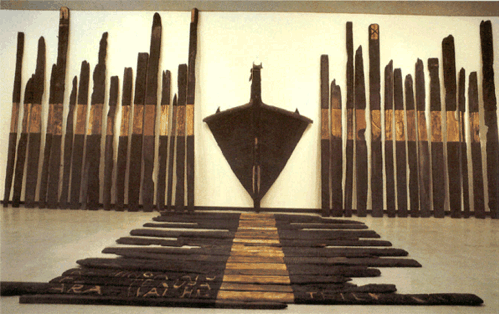
RALPH HOTERE Black Phoenix 1984-88 Burnt wood and metal, 5000 x 12900 x 5650 mm. (Collection of the Museum of New Zealand Te Papa Tongarewa)
But what kind of European? Certainly not British,(2) Germanic, Scandinavian or Slav, not Northern. In London where Hotere studied, on a New Zealand Art Societies Fellowship at the Central School of Art and Design from 1961, his work was shown at the Redfern Gallery,(3) the Royal Society of British Artists, the Royal College of Art (where Bill Culbert had recently completed an Associate Diploma with First Class Honours), the Whitechapel Art Gallery, and the QANTAS Gallery.
In 1999, Black Water, a large-scale installation by Hotere and Culbert, featured in Toi Toi Toi: Three Generations of Artists from New Zealand at the Museum Friedericianum Kassel, Germany, returned Hotere to Northern Europe. But in the exhibition Ralph Hotere: Black Light. Major works including collaborations with Bill Culbert, and its accompanying publication—’a collaborative project between Dunedin Public Art Gallery and the Museum of New Zealand Te Papa Tongarewa’(4)—there is abundant evidence of a Mediterranean sensibility, of affinities with the French (which he shares with Culbert), the Italians and the Spanish, with whose Latin cultures his biography and temperament are richly inflected.
In a magnificently evocative essay, ‘Tenebrae-transfigured Night. Ralph Hotere, a viable religious art and its traditions’, in the Black Light exhibition publication, Gregory O’Brien refers to ‘the hybridised Maori-Catholic tradition of his (the artist’s) upbringing.’(5) Hone Papita Raukura Hotere was brought up in a devout Roman Catholic family. His father, Tangirau, was a katikita (catechist); his mother, Ana Maria, was named for St Ann and her daughter, St Mary, the mother of Jesus. The Hahi Katorika tradition into which he was born near Mitimiti and baptised in 1931 had originated with French missionaries of the Society of Mary, under the leadership of Bishop Pompallier, active in Northland from 1838. (Hotere’s first two Christian names, Hone Papita, are transliterations, not of John the Baptist but of Jean-Baptiste, which was the Bishop’s name.) Although the French Marists had been succeeded at Mitimiti by an English order in the 1880s, the Mill Hill priests who served there had come from mainland Europe and, as O’Brien reasons, ‘may well have had a lasting influence on Hotere’.(6) He completed his secondary school education at St Peter’s Maori College (Hato Petera) in Auckland. Steeped in Catholic liturgy, theology, sacramentalism, mysticism, iconography and Latin texts, the young Hotere had been provided with a magnificent resource from which, as an artist, he would
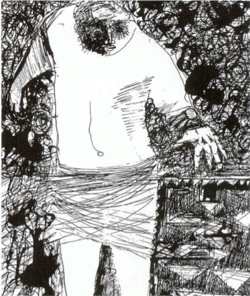
RALPH HOTERE Illustration for Te Ao Hou magazine, September 1963
Hotere’s affinity with mainland European modern religious art was already apparent in an expressionist painting of Christ illustrated in the Maori magazine Te Ao Hou in 1959.(7) As with the Wellington City Gallery’s exhibition Hotere: Out the Black Window: Ralph Hotere’s work with New Zealand poets, which toured New Zealand in 1997-8, Ralph Hotere. Black Light does not include examples of his early figurative work. (The seven severely abstract Black Paintings of 1968 are the earliest pieces in the exhibition.) Much of the selection however, revisits early preoccupations and memories and journeys to France, Italy and Spain. From London, in 1962, he went on to study on a Karolyi International Fellowship at Vence in the South of France. There Hotere marvelled at Henri Matisse’s iconographic and decorative scheme in the Dominican Chapel of the Rosary.
Hotere’s first exhibition in Europe was held at the Galérie Chandor, Tourette-sur-Loup, near Vence, in 1962. Back in England, his solo exhibition at the Middlesborough Municipal Art Gallery in Yorkshire in March 1964 was well reviewed in London’s Guardian newspaper. The ‘Frenchness’ of three of his four series of paintings was noted in the ‘ten-strong tachiste “white writing” Polaris series’ (Hotere’s response to the current Cuban missile crisis), the ‘five blood-red bullet-shattered works . . . in an Algeria series painted in Vence, the home of both the colonial [Algerian] opposition and Matisse’s famous Chapel,’ and the Woman series which included ‘a handful of square, chunky, art brut figures reminiscent of Dubuffet and one or two linear nudes that would not have shamed Picasso’.(8) (Many years later Selwyn Muru was to acknowledge the shaping influence of ‘our old koroua, Picasso’ on contemporary Maori art.) Art Brut, a movement associated with Jean Dubuffet, Tachisme, an aggressively physical method of painting,(9) and Nouveau Réalisme, a loose association of artists (including Arman, Jean Tinguely, César, Christo and Yves Klein) who assembled objets trouvés (discards) are all aspects of contemporary French art with which Hotere can be linked during this formative period of his career.
The fourth series of paintings exhibited at Middlesborough—meditations on the Sangro River War Cemetery on Italy’s Adriatic Coast where Hotere’s brother, Jack, lies buried(10)—owes more, perhaps, to Pop Art in the Jasper Johns-like stencilled numerals recording the ages of the young New Zealanders killed in action during the Second World War. The political nature of much of his art, his preoccupation with the human condition, evident in the ‘Sangro’ and ‘Human Rights’ series of paintings exhibited at Auckland’s Barry Lett Gallery on his return to New Zealand in 1965, was expressed, paradoxically, in the most reductive language of late modernism.
In 1978 Hotere returned to France in the company of Cilla McQueen (the poet and scholar in French literature whom he had married in 1973). Basing themselves at Avignon, a town dominated by the papal residence of the fourteenth-century Popes in exile, they struck out for Italy and Spain. McQueen recalls that ‘Pope Paul IV dies while we are in Avignon. The newspaper headlines blaze: ‘Le Pape Est Mort’, ‘E Morto Il Papa’. Later in the year when we were staying in Menorca his successor John Paul I also dies. Now the headlines are in Spanish: ‘El Papa Ha Muerto’.(11) The Return to Sangro (where he had hung over his brother’s gravestone a rosary provided by his aunt), The Pope is Dead, and the Window in Spain series, and the Avignon watercolours, were the fruits of this sojourn. Ten years later Hotere was back in Barcelona, the home of the great Spanish painter Antoni Tàpies. The series Lo Negro Sobre Lo Oro (the black over the gold) series begun in 1991 seems redolent of the continuing emotional and aesthetic appeal on Hotere of Spain and its great tradition of Catholic art. Much of the art in Black Light recalls the sumptuous austerity of Zurburan, the courtly elegance of Velazquez, the velvety blackness of the Spanish tenebrists, and the gilded altars of Spain’s cathedrals. O’Brien’s invocations of the sixteenth century Spanish mystic St John of the Cross in his theological reflections on Hotere’s art are entirely apposite.
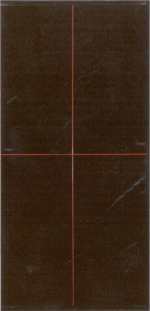
RALPH HOTERE Black Painting 1968 Lacquer on hardboard, 1230 x 623 mm. (Collection of the Govett-Brewster Art Gallery, New Plymouth)
‘Everything he touches turns to black,’ David Eggleton wittily observes of the artist.(12) Although Hotere can be a superb colourist, Black Light ‘is structured around two predominant concepts.’(13) One is the persistence of black in his work; the other is the importance in his practice ‘of the repetition of major serials, and of singular, large-scale installations’.(14) Of the paintings, the series Black Paintings has been likened in its extreme reductivism to the Black Paintings of Ad Reinhardt (from whose 1964 lecture given at the Institute of Contemporary Art in London, which Hotere missed, he quotes in the catalogue of his ‘Zero’ paintings show at the Barry Lett Gallery in 1967); at the same time Hotere’s shiny black, reflective lacquered surfaces, each featuring a perfectly centred, full-length, sharp, slit-like cross painted in one of the seven colours of the solar spectrum, are the very antithesis of the American painter’s self-effacing images.
Black Painting (1970) presents a contrast of matt acrylic paint on canvas with shiny, thin concentric circles, while Rosemary, portentously dated 1984, also acrylic on canvas, is a more gestural painting. Three works from the series Black Window (1981, 1982) are acrylic on hardboard, each set in a recycled wooden window frame. An even less yielding surface of glass also set within a window frame produces the mirror-like effect of Lo Negro Sobre Lo Oro (1992), Night Window, Carey’s Bay (1995) and 4 + 4 (1996), in which patches of gold leaf and gold dust provide a rich contrast with the black ground. In Aramoana (1982) ten lacquered sheets of corrugated iron, and Round Midnight and Black Cerulean (both 1999), lacquered corrugated aluminium and leadhead nails, complete the selection of wall pieces.
The most impressive works in Black Light are undoubtedly the installations: the Black Phoenix (1984-88) and those he created in collaboration with Bill Culbert: P.R.O.P, a high fence of black-lacquered sheets of corrugated iron and opaque white fluorescent tubes leaning against the gallery wall, and Pathway to the Sea — Aramoana, a long, continuous line of fluorescent tubes with a parallel band cut and polished across upended paua shells, both from 1991, and Blackwater (1999). In the exhibition’s Dunedin Public Art Gallery showing, Black Phoenix, with its charred timbers refashioned from the burnt hulk of the Poitrel placed at the far end of an otherwise large empty gallery, and dramatically lit, was heart-stopping. The whakatauki Hotere inscribed on some of The Pope is Dead works (although slightly differently worded), ‘Ka hinga atu he tetekura, ara mai he tetekura’—when one chief falls another rises to take his place—is lettered on the timbers in the foreground of Black Phoenix, thus alluding to the revivification and transformation of materials which is the alchemy of artmaking. Blackwater, the climax of the exhibition, might be thought to have its origins in Minimalism except that Dan Favin’s fluorescent tubes, have been drunkenly angled by Culbert as mooring posts, reflected in Hotere’s ‘estuary’ of corrugated iron sheets, a platform more elegant by far than Carl Andre’s plinth of readymade firebricks in Equivalent VIII (1996) at London’s Tate Modern. The corrugated iron sheets were spray-lacquered in situ in Kassel by the Mercedes Benz company. John Reynolds was astonished: ‘Ralph, all the way from Dunedin, with a lifetime of preoccupation with black, travels right across the world to one of the old European crucibles of culture and makes a request like that’.(15)
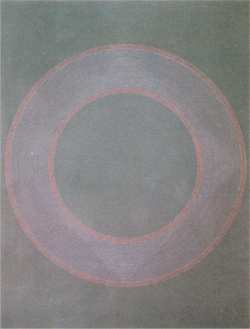
RALPH HOTERE Black Painting 1970 Acrylic on canvas, 1830 x 1400 mm. (Collection of the Museum of New Zealand Te Papa Tongarewa)
Wedde, Reynolds and O’Brien along with Francis Pound, Cilla McQueen and David Eggleton provide illuminating insider knowledge in elegantly written essays on Hotere in the beautifully produced, lavishly illustrated publication, the taonga pukapuka which accompanies the exhibition. A superb chronology,(16) compiled by Elizabeth Kerr and Mary Trewby, completes the book. Reynolds—the one committed painter amongst the writers—Pound is an academic art historian, while the others are all primarily writers and anthologised poets—tells of his experience of collaborating with Hotere. In ‘Tiger Country: Hotere, Reinhardt and the US Masters’, Pound cleverly draws together, within the context of the 1997 US Masters Tournament dominated by the brilliant American golfer Tiger Woods, Hotere’s passion for golf with his ‘longstanding . . . painterly relation’ to Ad Reinhardt’.
All of the writers reflect with insight on the paradoxes that lie at the heart of Hotere’s art, none more so than Wedde. Perhaps the greatest paradox of all is the relative sparseness of critically reflective writing on the artist. As Wedde puts it, ‘Given the scope and consistency of Hotere’s work, there are few catalogues, and none of substance . . . it’s as though he presents the profession of art history, or even of a wider, generalist cultural history, with some particular difficulties.’(17) Some particular difficulties for the art historian are the sheer volume, variety and contextual complexity of Hotere’s art in his restlessly, endlessly inventive career.
On the one hand his origins in a small Maori Catholic community have continued to warm the emotional and spiritual heart of his art. He is, after all, a Maori artist of great originality and ingenuity. With his hard-case do-it-yourself practicality—his cheerful (ab)use of power tools and industrial materials, especially those of the Kiwi vernacular such as corrugated iron, leadheaded nails, fence posts and recycled timbers, and even number eight wire—Hotere also belongs at the forefront of mainstream New Zealand art history. But in a sense he also stands outside it, both as a Maori and as one of the most cosmopolitan, sophisticated, international artists New Zealand has yet produced.
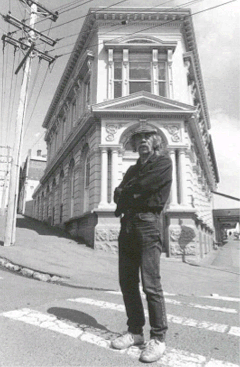
Ralph Hotere in front of studio in old Bank of New Zealand building, Port Chalmers 1991 (Photograph: Otago Daily Times)
Hotere’s inclusion amongst the five hundred artists represented by full-page colour plates in The 20th-Century Art Book, published in 1996 by Phaidon Press may point to a different reading of his achievements. The book encompasses ‘celebrated works’ by ‘old favourites such as Monet, Picasso, Dali and Hockney’ along with examples of ‘future classics’ by some of ‘the most innovative contemporary artists’.(18) Colin McCahon and Ralph Hotere (but not Len Lye) are represented amongst the latter — McCahon by Are there not twelve hours of daylight (1970) and Hotere by Aramoana nineteen-eighty-four (1984), both paintings from the Chartwell Collection then held in the Waikato Museum of Art and History.(19) Hotere sits much more comfortably with this illustrious group than McCahon, who in this company looks decidedly odd. Affinities with Carl Andre, Alberto Burri (and Arte Povera, generally), Jim Dine, Jean Dubuffet, Jasper Johns (though Hotere’s Black Union Jack works of 1981 seem like a mordant reversal of Johns’ ‘Stars and Stripes’ paintings of 1954-55) and Donald Judd’s metal boxes and shelves, Malevich, Robert Mangold, Matisse, Reinhardt, the suave viscosity of Pierre Soulages, and the ‘white writing’ of Tobey may be discerned in Hotere’s art.
But there are two artists with whom Hotere might, with profit, be closely compared: the French Nouveau Realiste, Yves Klein and the Barcelona-born painter, Antoni Tàpies. Tàpies (b. 1923) is the inheritor of the rich culture of Catholic Spain with which Hotere has demonstrated a particular empathy. Noted for his use of ordinary materials, Tàpies’ signature motif is the crux decussata (the X-shaped cross) which, as O’Brien notes, recurs in Hotere’s art (along with the crucifix and the eucharistic emblems). Klein was amongst the earliest modernists to paint monochromes in brilliant ultramarine (in contrast to Hotere’s black). Klein’s Cosmogenies (1960) were produced by means of natural weathering by exposure to air and water, as were Hotere’s Song Cycle banners in 1976. Klein’s Fire-Paintings reveal the destructive effects of a blowtorch, a device that Hotere was later to apply to stainless steel. Klein’s emptying out of the Galérie Iris Clert in Paris in 1958 foreshadows by twenty-one years Billy Apple’s performance work The Given as an Art-Political Statement (Censure), in which Hotere participated at the Bosshard Galleries in Dunedin. Hotere’s art has always seemed to resonate with something like a French sensibility, that links it with the belle matière tradition of modern French painting, and the reaction against it, as it was carried forward by the cosmopolitan artists of the New School of Paris in the ’50s and ‘60s. If Hotere is to find his niche in the international art world, as seems highly likely, it will be the European civility, sensitivity, elegance and sheer gorgeousness of his art that will earn him his place there.
1. Mark Young, New Zealand Art: Painting 1950-1967, A.H. & A.W. Reed, Wellington, 1968. 2. Although New Zealanders remained British subjects until Britain entered the European Economic Community in 1975. 3. With which New Brighton-born New Zealander Rex Nan Kivell had been associated since 1925. From 1931 until his death in 1977, Nan Kivell was the Managing Director. 4. Ralph Hotere: Black Light. Major Works Including Collaborations with Bill Culbert, Te Papa Press/Dunedin Public Art Gallery, Wellington & Dunedin 2000, p. vi. 5. Black Light, p. 27. 6. Black Light, p. 33. 7. Te Ao Hou, December 1959, p. 39. 8. Black Light, p. 112. 9. Hotere would have seen the exhibition British Abstract Painting which toured New Zealand in 1958. This was based on the exhibition Metavisual, Tachiste, Abstract Painting in Britain Today, shown at the Redfern Gallery in 1957. Through Countess Katherine Karolyi, Hotere met Roland Penrose who organised Hotere’s first London shows at the Redfern Gallery in 1963 and 1964. 10. Private J. Hotere was killed in action on 21 December 1943. 11. Black Light, p. 45. 12. Black Light, p. 52. 13. Black Light, p. viii. 14. Black Light, p. viii. 15. Black Light, p. 8. 16. Although precise dates of some exhibitions are missing. 17. Black Light, p. 51. 18. The 20th-Century Art Book, Phaidon, London 1996. 19. I am grateful to Andrea Dornauf, Registrar, Chartwell Collection, and Lara Strongman, formerly Curator of Fine Arts at the Waikato Museum of Art and History, now at the City Gallery, Wellington, for clarifying these matters with me. 20. Black Light, p. 33.
Ralph Hotere: Black Light. Major Works Including Collaborations with Bill Culbert, an exhibition curated by Gwynneth Porter, John Walsh and Ian Wedde for the Museum of New Zealand Te Papa Tongarewa and the Dunedin Public Art Gallery. Dunedin Public Art Gallery, March-May 2000; Auckland Art Gallery Toi o Tamaki, June-August 2000; The Museum of New Zealand Te Papa Tongarewa, October 2000-February 2001
